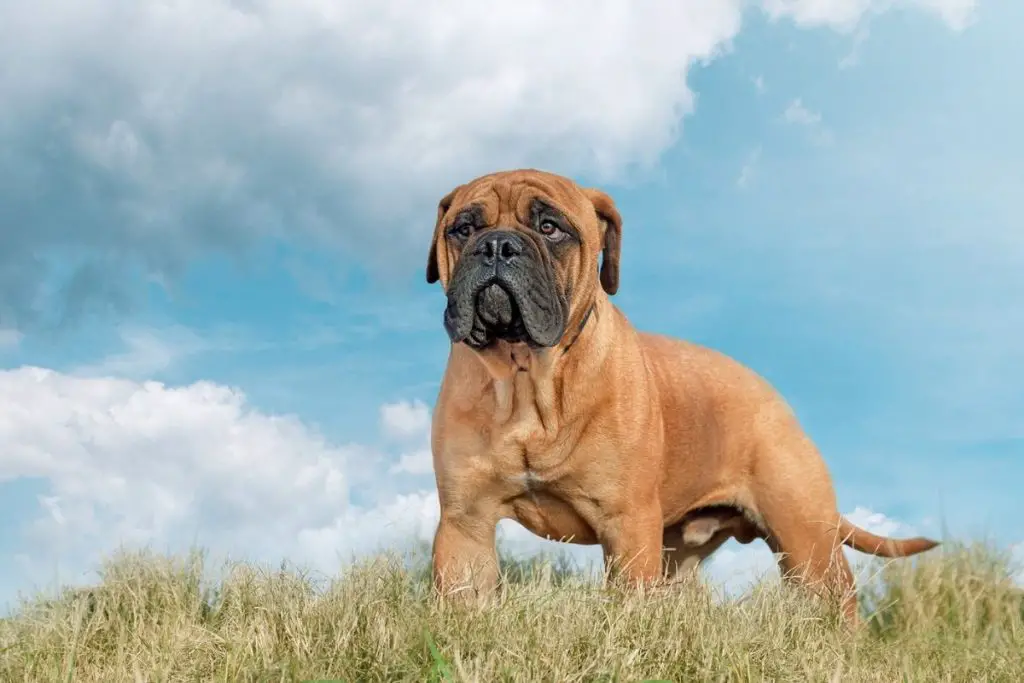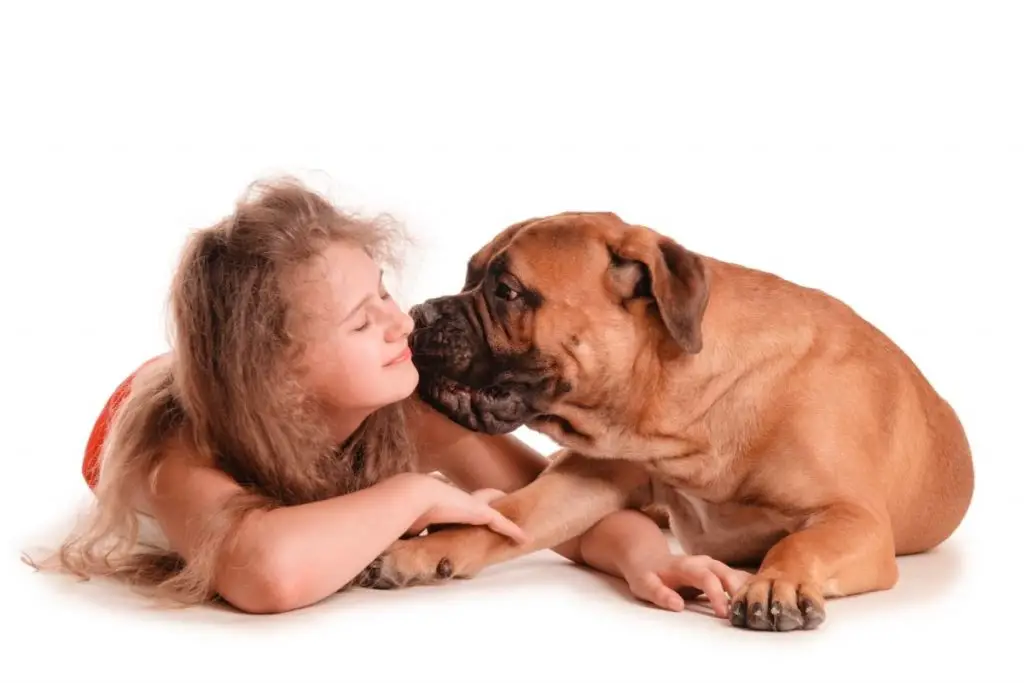Table of Contents

Have you always liked bullmastiffs? These large and strong looking dogs are impressive, intelligent and make great family dogs. But, if you are considering getting one of these dogs, you may have heard that they are aggressive.
Some people may have told you otherwise, but now you are unsure whether the bullmastiff is aggressive or not.
You are in luck, in this article we are going to look at this breed in detail to try and determine whether they are aggressive as a whole.
So, without further ado, let us begin by learning a bit about the breed in general.
About The Breed
The bullmastiff is a large and powerful dog. Despite their large size and intimidating look, they are actually quite laid back and affectionate dogs.
With the right training, they make excellent family pets and even get along with children who know how to respect them.
But, there is a lot more we can learn about this breed, so without further ado, let us break down the information surrounding this breed.
Physical Traits And Expectations
The bullmastiff is a large dog, the males can grow between 25 and 27 inches tall, they can also weigh between 110 and 130 pounds.
The females tend to grow between 24 and 26 inches tall, and they typically weigh between 100 and 120 pounds.
They have smooth short haired coats and come in several colors, some of which include:
- Red Fawn
- Fawn
- Red Brindle
- Red Fawn Brindle
- Red
- Fawn Brindle
As for the markings, the standard is a black mask, which is typical for this breed of dog.
These gentle giants have flopped over ears and tend to live between 7 and 9 years. The bullmastiff has a tendency to snore and drool, so watch out for slobbering around the house if you keep one of these dogs in your home.
These guardian dogs will do best if they get 40 or more hours of exercise a day. They do not tend to dig or bark much as a rule.
But this may change depending on their environment, situation, training and many other factors.
Temperament

The bullmastiff is a gentle giant, they are affectionate dogs and with early socialization are excellent family dogs.
Their laid back nature is one thing that makes them brilliant family dogs, but it is recommended that any children around this breed are reasonably well-behaved.
Socialization is very important because these dogs are naturally quite suspicious of those that are not a part of their family.
While the bullmastiff is a family orientated and loyal dog, they are not to be walked all over. They can be independent creatures, which makes training a bit of a challenge.
In fact, the bullmastiff may be less friendly to other pets around your home than strange people.
So, if you want to add one of these dogs to your family, be cautious if you have other pets. Socialization will be of paramount importance and will help to avoid any incidents.
Trainability
The bullmastiff needs to begin their training while they are puppies. They tend to be strong-willed which can come across as stubborn, because of this both wonder and dog will need a training regiment.
These dogs can get quite good at scent work, obedience, tracking, agility, and so with the right training regime that can really achieve anything.
The key is beginning early and to also socialize them as soon as you are able.
Nutrition
Bullmastiffs should be fed food for large dogs. Puppies should get a type of food that is for puppies as well. But, the reason for specific foods is that these dogs tend to grow quite quickly, which can be taxing on them.
The large dog food helps to make them grow steadily while giving them everything that they require to grow.
As a rule, this breed should be kept lean. Feeding adults twice a day is a good way to go about it.
The reason for this is so that bloat does not form as a result of ingesting too much food at once.
Health
This breed is large and tends to have quite dense bones. Because of this, breeders must take care to follow the standard so that there are no issues within the line.
These dogs are bred to be guardian dogs and need to be fit both mentally and physically. Because of this, responsible breeders will screen for the following issues:
- Elbow Evaluation
- Hip Evaluation
- Thyroid Evaluation
- Ophthalmologist Evaluation
- Cardiac Exam
As with many breeds, there are issues that can develop. Some that are hereditary and others from external sources.
So, while you have to look out for things like bloat and cancer in this breed, it is important to work with reputable breeders that only breed sound dogs that are healthy and sound.
History Of The Bullmastiff
The bullmastiff first came about around the 19th century.
British gamekeepers wanted a dog that could help protect country estates from poachers. So, they needed a large dog that could move quickly.
By cross-breeding the larger mastiff and British bulldog, the bullmastiff was born. These powerful dogs were agile, fast and able to knock poachers to the ground with ease.
They held these packers to the ground until their gamekeeper could intervene and apprehend the criminal.
But today these dogs are better family pets and can be seen lounging around the homes of many people around the world.
Fun Facts
Bullmastiffs are interesting dogs and there are certainly some fun facts you can learn about them. So in this section of the article, we are going to look at a few fun facts surrounding this breed of dog.
- Quiet and Gentle: This breed is not aggressive dogs and do not tend to bark or bite much. That is because when they first appeared, the breeders wanted a dog that would apprehend poachers and not maul them. This gentle instinct has remained with the bullmastiff even within today’s bullmastiffs.
- Famous: Bullmastiffs are famous in today’s media and have appeared in the Rocky movies and been the chosen pets of many celebrities such as Michael Bay, Jon Bon Jovi, Bob Dylan and many more.
- Guard Dogs: This breed was originally created to watch over the property of wealthy landowners and was specifically bred to apprehend poachers without injuring them.
- Mascot: The bullmastiff is a mascot of the NFL, his name is Swagger and if you are lucky you might see him during a game, and he even gives interviews afterwards.
- John D. Rockefeller: The first time the bullmastiff appeared in the United States was in the 1920s when John D. Rockefeller the wealthy oil tycoon brought them over to watch over his estate in Tarrytown New York.
- Exercise: Even though these dogs are large, they are only moderately energetic and will be content with only a few shorter walks a day. On top of that, they do not like it when the weather is hot.
Frequently Asked Questions About The Breed
If you aren’t dying to get a hold of one of these dogs, there is still time to convince you that they are amazing and passive dogs that will fit perfectly into your little family.
In his section, we are going to look at some frequently asked questions surrounding the breed and answer them to the best of our ability. So, without further ado, let us begin.
Are Bullmastiffs Aggressive?
Bullmastiffs are not aggressive by nature, at least not any more than any other breed of dog you will see.
As with almost any dog, they need to be socialized early, so they understand how to interact with people and other dogs. But, as a whole, the bullmastiff is a very laid back dog and is not likely to be aggressive.
Is the Bullmastiff A Good Family Dog?
This breed of dog is typically very gentle and affectionate with those in their family.
The easy-going and calm nature of this breed makes them excellent family dogs. But, they can be suspicious of strangers entering the home.
So, make sure to train them while they are young, so they are socialized properly.
Are Bullmastiffs A Healthy Breed?
In general, bullmastiffs are a healthy breed of dig.
However, as with many breeds of dog there are those that they are susceptible to, especially if there are external issues in their environment or within their lives.
Infections, parasites and diet for example might make them sick. But, this is the case for almost every dog out there.
Will A Bullmastiff Bite?
The answer to this question can be generalized. Yes, if you push them.
But as a rule the bullmastiff was bred to hold intruders without mauling them and are so unlikely to bite unless they are provoked or have been mistreated in their lives.
Are Bullmastiffs Good For First Time Owners?
This breed requires a high level of training, this is because they have a tendency to be independent and can be stubborn.
If you are not experienced in dogs, you might have trouble training your puppy or skip out on training altogether. In the end, you may well end up with a 130 pound dog that does not know how to behave.
So, this dog is not recommended to owners that are not familiar with dogs or training.
Final Thoughts
That is all for this article, we hope that you have learned a lot about the gentle and laid back bullmastiff. They are genuinely a gentle breed and are not aggressive.
These friendly giants are wonderful and affectionate dogs that make excellent family pets.
